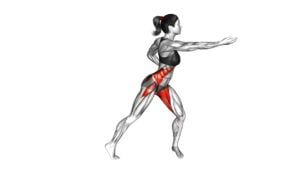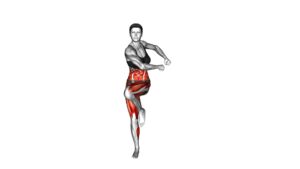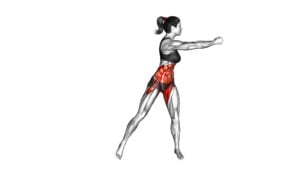Twist Chest Out (female) – Video Exercise Guide & Tips

Get ready to twist your chest out and feel the burn!
Watch This Exercise Video
In this video exercise guide, we'll show you the proper form and technique for the Twist Chest Out exercise.
Whether you're a beginner or an experienced fitness enthusiast, we've got variations and modifications to suit your fitness level.
Plus, we'll share tips to maximize the effectiveness of this exercise.
So grab your mat and get ready to sculpt those chest muscles like never before!
Key Takeaways
- The twist chest out exercise tones and strengthens the chest muscles.
- It improves overall upper body strength and posture.
- The exercise targets the pectoralis major and minor muscles.
- Engaging the core during the twist enhances core strength and stability.
Benefits of the Twist Chest Out Exercise
You can experience several benefits from performing the Twist Chest Out exercise. This exercise is known for its twisting movements, which can help tone and strengthen your chest muscles. By engaging in this exercise regularly, you can improve your overall upper body strength and posture.
One of the main benefits of twist chest out exercises is that they target the muscles in your chest, particularly the pectoralis major and minor. These muscles are responsible for movements such as pushing and lifting, so strengthening them can enhance your everyday activities and sports performance.
Additionally, the twisting movements involved in this exercise can help improve your core strength and stability. As you twist your torso, you engage the muscles in your abdomen, obliques, and lower back. This can lead to a more stable and balanced body, reducing the risk of injuries and improving your overall fitness level.
Furthermore, the Twist Chest Out exercise can also promote better flexibility in your upper body. The rotational movements involved in this exercise can increase the range of motion in your shoulders, chest, and spine, allowing for better mobility in daily activities and reducing the risk of muscle imbalances.
Proper Form and Technique for Twist Chest Out
To perform the Twist Chest Out exercise with proper form and technique, it's essential to focus on engaging your core muscles throughout the movement. This will help stabilize your body and prevent strain on your shoulders.
Core Engagement During Twist
Ensure proper core engagement by actively contracting your abdominal muscles during the Twist Chest Out exercise. By focusing on core stability, you can maximize the effectiveness of this exercise and prevent injury. Here are some tips to help you engage your core properly during the Twist Chest Out:
- Before starting the exercise, take a deep breath and draw your belly button in towards your spine.
- Maintain a neutral spine throughout the movement, avoiding any excessive arching or rounding of the back.
- As you twist, imagine rotating from your waist, allowing your oblique muscles to activate.
- Keep your abdominal muscles engaged during the entire exercise, avoiding any unnecessary movement or tension in the neck or shoulders.
Avoiding Shoulder Strain
Maintaining proper form and technique during the Twist Chest Out exercise is crucial for avoiding shoulder strain. To protect your shoulders, it's essential to focus on shoulder mobility and incorporate stretching exercises into your routine.
Before starting the exercise, make sure your posture is correct, with your shoulders relaxed and down. Engage your core and keep your spine aligned throughout the movement.
As you twist your torso, be mindful of your shoulders and prevent them from hunching or rolling forward. Instead, aim to maintain an open chest and pull your shoulder blades back and down. This will help to alleviate any strain on your shoulders and promote proper alignment, reducing the risk of injury.
Common Mistakes to Avoid During Twist Chest Out
To ensure you perform the Twist Chest Out exercise correctly and minimize the risk of injury, there are a few common mistakes you should avoid.
First, make sure to maintain proper form throughout the exercise by keeping your core engaged and your back straight.
Additionally, be mindful of not twisting too forcefully or quickly, as this can strain your muscles.
Proper Form Tips
During the Twist Chest Out exercise, it's important to focus on keeping your body aligned and avoiding common mistakes that can hinder your progress. Here are some proper form tips to help you maximize your results and maintain proper breathing techniques:
- Engage your core: Before starting the exercise, activate your core muscles by pulling your belly button towards your spine. This will help stabilize your torso and protect your lower back.
- Maintain proper posture: Keep your chest lifted and your shoulders relaxed throughout the movement. Avoid rounding your back or hunching your shoulders forward.
- Twist from the waist: Initiate the movement from your waist, not your shoulders. Twist your upper body to one side while keeping your hips stable and facing forward.
- Breathe rhythmically: Inhale deeply before starting the twist, and exhale as you twist your upper body. This will help you maintain a steady rhythm and control your movements.
Injury Prevention Techniques
To prevent injury while performing the Twist Chest Out exercise, it's important to be mindful of common mistakes and make adjustments as needed. One of the key injury prevention techniques is to always start with a proper warm-up. This helps to prepare your muscles and joints for the movement, reducing the risk of strains or sprains.
Incorporate dynamic stretches and light cardio exercises to increase blood flow and flexibility. Additionally, it's crucial to maintain proper form throughout the exercise. Avoid twisting too forcefully or using momentum to complete the movement. Instead, focus on engaging your core muscles and using controlled movements.
Lastly, listen to your body and take breaks when needed. Pushing yourself too hard can lead to overexertion and potential injuries. Remember, injury prevention is key to a successful workout routine.
Variations and Modifications for Different Fitness Levels
Looking to modify the twist chest out exercise for different fitness levels? Whether you're a beginner just starting your fitness journey or an advanced exerciser looking for a challenge, there are modifications and advanced variations you can try to tailor the exercise to your fitness level. Here are some options to consider:
- Modifications for beginners:
- Start with a smaller range of motion: If the twist chest out exercise feels too challenging, you can start by performing smaller twists until you build up strength and flexibility.
- Use lighter weights or no weights: If you find it difficult to perform the exercise with weights, you can begin by using lighter dumbbells or no weights at all. This allows you to focus on proper form and technique.
- Perform the exercise from a seated position: If standing is too challenging, you can modify the exercise by performing it while seated on a chair or stability ball. This helps to reduce the load on your lower body and core.
- Advanced variations:
- Increase the weight: If you're comfortable with the twist chest out exercise, you can challenge yourself by increasing the weight of the dumbbells or using resistance bands.
- Add a balance element: Incorporate balance by performing the exercise on one leg or on an unstable surface like a Bosu ball. This engages your core and challenges your stability.
- Speed up the movement: Increase the tempo of the exercise to add a cardiovascular element and make it more challenging.
- Combine with other exercises: Integrate the twist chest out exercise into a circuit or superset with other upper body exercises to create a more advanced workout.
Remember to listen to your body and choose modifications or variations that are appropriate for your fitness level. As you progress, you can gradually increase the difficulty to continue challenging yourself and achieving your fitness goals.
Tips for Maximizing the Effectiveness of Twist Chest Out
To maximize the effectiveness of the twist chest out exercise, focus on maintaining proper form and engaging your core throughout the movement. By doing so, you can ensure that you're targeting the intended muscles and maximizing the results of your workout.
First and foremost, it's crucial to maintain proper form while performing the twist chest out exercise. Keep your back straight and your shoulders relaxed. Avoid hunching or rounding your back, as this can put unnecessary strain on your spine. Additionally, make sure to keep your chest lifted and your gaze forward. This will help engage your core and prevent any unnecessary tension in your neck and shoulders.
Engaging your core is key to getting the most out of this exercise. As you twist your torso, focus on contracting your abdominal muscles. This won't only help strengthen your core but also enhance the effectiveness of the exercise. Remember to breathe throughout the movement. Inhale as you prepare to twist and exhale as you twist your torso. This breathing technique will promote relaxation and allow for deeper engagement of your core muscles.
Safety Precautions and Considerations for Twist Chest Out
Before attempting the twist chest out exercise, ensure you're aware of the safety precautions and considerations. Here are some important points to keep in mind:
- Proper form: Maintaining proper form is crucial to prevent injuries. Make sure to keep your back straight, engage your core, and avoid excessive twisting or jerking movements.
- Start with warm-up exercises: It's essential to warm up your body before performing any exercise. This helps increase blood flow to the muscles, improves flexibility, and reduces the risk of injury. Consider incorporating dynamic stretches or light cardio exercises into your warm-up routine.
- Listen to your body: Pay attention to any discomfort or pain during the exercise. If you experience any sharp pain or feel overwhelmed, stop immediately. It's important to know your limits and not push yourself beyond what your body can handle.
- Consult a professional: If you're new to the twist chest out exercise or have any underlying health conditions, it's advisable to consult with a fitness professional or healthcare provider. They can guide you on proper technique, provide modifications if needed, and ensure your safety throughout the exercise.
Frequently Asked Questions
How Many Calories Does the Twist Chest Out Exercise Burn?
The twist chest out exercise can help you burn calories and tone your chest muscles. While the exact number of calories burned depends on factors like your weight and intensity, this exercise is generally considered a good way to increase your heart rate and burn calories.
If you're looking for alternative exercises, you could try chest presses, push-ups, or dumbbell flyes. Remember to always consult with a fitness professional before starting any new exercise routine.
Can the Twist Chest Out Exercise Help Reduce Breast Size?
The Twist Chest Out exercise is a great way to target your chest muscles and improve overall upper body strength.
While it can help tone and shape your chest, it's important to note that it isn't specifically designed to reduce breast size.
If you're looking for breast reduction alternatives, it's best to consult with a healthcare professional who can provide you with personalized advice based on your specific needs and goals.
Is the Twist Chest Out Exercise Safe for Pregnant Women?
The twist chest out exercise may not be safe for pregnant women due to the twisting motion involved. However, there are alternative exercises that can be done during pregnancy to strengthen the chest muscles.
These exercises include modified versions of the twist chest out exercise, such as standing chest presses or seated chest flies.
It's important to consult with a healthcare professional or a certified fitness instructor for guidance on safe exercises during pregnancy.
Can the Twist Chest Out Exercise Be Done Without Equipment?
Yes, you can definitely do the twist chest out exercise without any equipment. This exercise is great for strengthening your chest and core muscles.
If you don't have access to equipment, there are alternative exercises you can try, such as standing twists or seated twists. These exercises offer similar benefits to the twist chest out, helping improve your upper body strength and posture.
Remember to always listen to your body and consult with a professional if you have any concerns or limitations.
How Long Should I Hold the Twist Chest Out Position for Maximum Benefits?
To get the maximum benefit from the twist chest out exercise, it's important to hold the position for the right amount of time. By doing so, you engage your chest muscles and improve your overall strength and stability.
The proper form for the twist chest out involves keeping your back straight and your core engaged. Aim to hold the position for around 10 to 15 seconds, gradually increasing the duration as you get stronger. This will help you reap the benefits of the exercise.
Conclusion
In conclusion, the twist chest out exercise is a beneficial workout that targets the chest muscles. By following proper form and technique, you can maximize the effectiveness of this exercise.
Avoiding common mistakes and making variations according to your fitness level are also important. Remember to prioritize safety by considering any precautions and modifications necessary for your individual needs.
With these tips in mind, you can confidently incorporate twist chest out into your fitness routine for improved chest strength and tone.

Author
Years ago, the spark of my life’s passion ignited in my mind the moment I stepped into the local gym for the first time. The inaugural bead of perspiration, the initial endeavor, the very first surge of endorphins, and a sense of pride that washed over me post-workout marked the beginning of my deep-seated interest in strength sports, fitness, and sports nutrition. This very curiosity blossomed rapidly into a profound fascination, propelling me to earn a Master’s degree in Physical Education from the Academy of Physical Education in Krakow, followed by a Sports Manager diploma from the Jagiellonian University. My journey of growth led me to gain more specialized qualifications, such as being a certified personal trainer with a focus on sports dietetics, a lifeguard, and an instructor for wellness and corrective gymnastics. Theoretical knowledge paired seamlessly with practical experience, reinforcing my belief that the transformation of individuals under my guidance was also a reflection of my personal growth. This belief holds true even today. Each day, I strive to push the boundaries and explore new realms. These realms gently elevate me to greater heights. The unique combination of passion for my field and the continuous quest for growth fuels my drive to break new ground.



